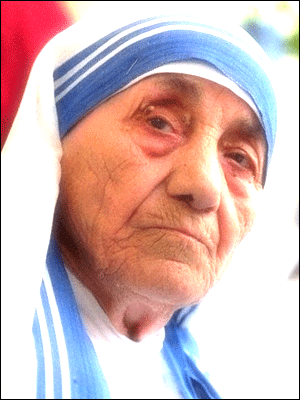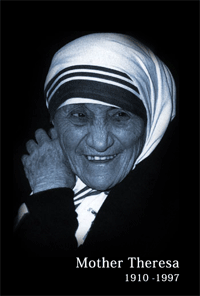After a few months of training at the Institute of the Blessed Virgin Mary in Dublin Mother Teresa came to India on 6 January 1929. On May 24, 1931, she took her initial vows as a nun. From 1931 to 1948, Mother Teresa taught geography and catechism at St. Mary's High School in Calcutta. On 24 May 1937, Sister Teresa made her Final Profession of Vows, becoming, as she said, the “spouse of Jesus” for “all eternity.” From that time on she was called Mother Teresa. She continued teaching at St. Mary’s and in 1944 became the school’s principal. A person of profound prayer and deep love for her religious sisters and her students, Mother Teresa’s twenty years in Loreto were filled with profound happiness. Noted for her charity, unselfishness and courage, her capacity for hard work and a natural talent for organization, she lived out her consecration to Jesus, in the midst of her companions, with fidelity and joy.
Mother Teresa's words are
 “By
blood, I am Albanian. By citizenship, an Indian. By faith, I am a
Catholic nun. As to my calling, I belong to the world. As to my heart, I
belong entirely to the Heart of Jesus. ”Small of stature, rocklike in
faith, Mother Teresa of Calcutta was entrusted with the mission of
proclaiming God’s thirsting love for humanity, especially for the
poorest of the poor. “God still loves the world and He sends you and me
to be His love and His compassion to the poor.” She was a soul filled
with the light of Christ, on fire with love for Him and burning with one
desire: “to quench His thirst for love and for souls.”
“By
blood, I am Albanian. By citizenship, an Indian. By faith, I am a
Catholic nun. As to my calling, I belong to the world. As to my heart, I
belong entirely to the Heart of Jesus. ”Small of stature, rocklike in
faith, Mother Teresa of Calcutta was entrusted with the mission of
proclaiming God’s thirsting love for humanity, especially for the
poorest of the poor. “God still loves the world and He sends you and me
to be His love and His compassion to the poor.” She was a soul filled
with the light of Christ, on fire with love for Him and burning with one
desire: “to quench His thirst for love and for souls.” On 10 September 1946 during the train ride from Calcutta to Darjeeling for her annual retreat, Mother Teresa received her “inspiration,” her “call within a call.” On that day, in a way she would never explain, Jesus’ thirst for love and for souls took hold of her heart and the desire to satiate His thirst became the driving force of her life. Over the course of the next weeks and months, by means of interior locutions and visions, Jesus revealed to her the desire of His heart for “victims of love” who would “radiate His love on souls.” “Come be My light,” He begged her. “I cannot go alone.” He revealed His pain at the neglect of the poor, His sorrow at their ignorance of Him and His longing for their love. He asked Mother Teresa to establish a religious community, Missionaries of Charity, dedicated to the service of the poorest of the poor. However, the prevailing poverty in Calcutta had a deep impact on Mother Teresa's mind and in 1948, she received permission from her superiors to leave the convent school and devote herself to working among the poorest of the poor in the slums of Calcutta . On August 17, 1948, she dressed for the first time in a white, blue-bordered sari and passed through the gates of her beloved Loreto convent to enter the world of the poor.
After a short course with the Medical Mission Sisters in Patna, she returned to Calcutta and found temporary lodging with the Little Sisters of the Poor. She started an open-air school for homeless children. Soon she was joined by voluntary helpers, and she received financial support from church organizations and the municipal authorities. On 21 December she went for the first time to the slums. On October 7, 1950, Mother Teresa received permission from the Vatican to start her own order. Vatican originally labeled the order as the Diocesan Congregation of the Calcutta Diocese, and it later came to known as the "Missionaries of Charity". The primary task of the Missionaries of Charity was to take care of those persons who nobody was prepared to look after.
 She
visited families, washed the sores of some children, cared for an old
man lying sick on the road and nursed a woman dying of hunger and TB.
She started each day in communion with Jesus in the Eucharist and then
went out, rosary in her hand, to find and serve Him in “the unwanted,
the unloved, the uncared for.” After some months, she was joined, one by
one, by her former students. By the early 1960s, Mother Teresa began to
send her Sisters to other parts of India. The Decree of Praise granted
to the Congregation by Pope Paul VI in February 1965 encouraged her to
open a house in Venezuela. It was soon followed by foundations in Rome
and Tanzania and, eventually, on every continent. Starting in 1980 and
continuing through the 1990s, Mother Teresa opened houses in almost all
of the communist countries, including the former Soviet Union, Albania
and Cuba.
She
visited families, washed the sores of some children, cared for an old
man lying sick on the road and nursed a woman dying of hunger and TB.
She started each day in communion with Jesus in the Eucharist and then
went out, rosary in her hand, to find and serve Him in “the unwanted,
the unloved, the uncared for.” After some months, she was joined, one by
one, by her former students. By the early 1960s, Mother Teresa began to
send her Sisters to other parts of India. The Decree of Praise granted
to the Congregation by Pope Paul VI in February 1965 encouraged her to
open a house in Venezuela. It was soon followed by foundations in Rome
and Tanzania and, eventually, on every continent. Starting in 1980 and
continuing through the 1990s, Mother Teresa opened houses in almost all
of the communist countries, including the former Soviet Union, Albania
and Cuba. The physical and spiritual needs of the poor, Mother Teresa founded the Missionaries of Charity Brothers in 1963, in 1976 the contemplative branch of the Sisters, in 1979 the Contemplative Brothers, and in 1984 the Missionaries of Charity Fathers. She formed the Co-Workers of Mother Teresa and the Sick and Suffering Co-Workers, people of many faiths and nationalities with whom she shared her spirit of prayer, simplicity, sacrifice and her apostolate of humble works of love. This spirit later inspired the Lay Missionaries of Charity. In answer to the requests of many priests, in 1981 Mother Teresa also began the Corpus Christi Movement for Priests as a “little way of holiness” for those who desire to share in her charism and spirit.
She has received a number of awards and distinctions Numerous awards, beginning with the Indian Padmashri Award in 1962 and notably the Nobel Peace Prize in 1979, honoured her work, while an increasingly interested media began to follow her activities. She received both prizes and attention “for the glory of God and in the name of the poor.” These include the Pope John XXIII Peace Prize (1971), Nehru Prize for Promotion of International Peace & Understanding (1972), Balzan Prize (1978), Nobel Peace Prize (1979) and Bharat Ratna (1980).
The whole of Mother Teresa’s life and labour bore witness to the joy of loving, the greatness and dignity of every human person, the value of little things done faithfully and with love, and the surpassing worth of friendship with God. On March 13, 1997, Mother Teresa stepped down from the head of Missionaries of Charity. On 5 September Mother Teresa’s earthly life came to an end. She died on September 5, 1997, just 9 days after her 87th birthday. She was given the honour of a state funeral by the Government of India and her body was buried in the Mother House of the Missionaries of Charity. Her tomb quickly became a place of pilgrimage and prayer for people of all faiths, rich and poor alike. Mother Teresa left a testament of unshakable faith, invincible hope and extraordinary charity. Her response to Jesus’ plea, “Come be My light,” made her a Missionary of Charity, a “mother to the poor,” a symbol of compassion to the world, and a living witness to the thirsting love of God. Following Mother Teresa's death, the Holy See began the process of beatification, the second step towards possible canonization, or sainthood.
Less than two years after her death, in view of Mother Teresa’s widespread reputation of holiness and the favours being reported, Pope John Paul II permitted the opening of her Cause of Canonization. On 20 December 2002 he approved the decrees of her heroic virtues and miracles.
She inspires me a lot for how to love each other without any discrimination. She love is pure from herself and from God. I think if we love each other like mother Theresa there will no more war in this world. And the world will be in the peace for ever.







